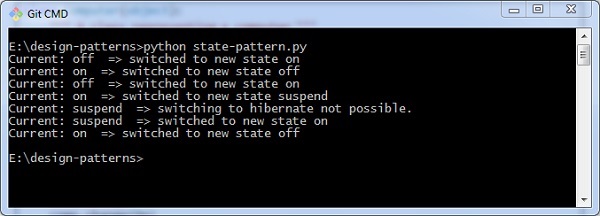
- Python Design Patterns Tutorial
- Python Design Patterns - Home
- Introduction
- Python Design Patterns - Gist
- Model View Controller Pattern
- Python Design Patterns - Singleton
- Python Design Patterns - Factory
- Python Design Patterns - Builder
- Python Design Patterns - Prototype
- Python Design Patterns - Facade
- Python Design Patterns - Command
- Python Design Patterns - Adapter
- Python Design Patterns - Decorator
- Python Design Patterns - Proxy
- Chain of Responsibility Pattern
- Python Design Patterns - Observer
- Python Design Patterns - State
- Python Design Patterns - Strategy
- Python Design Patterns - Template
- Python Design Patterns - Flyweight
- Abstract Factory
- Object Oriented
- Object Oriented Concepts Implementation
- Python Design Patterns - Iterator
- Dictionaries
- Lists Data Structure
- Python Design Patterns - Sets
- Python Design Patterns - Queues
- Strings & Serialization
- Concurrency in Python
- Python Design Patterns - Anti
- Exception Handling
- Python Design Patterns Resources
- Quick Guide
- Python Design Patterns - Resources
- Discussions
Python Design Patterns - State
It provides a module for state machines, which are implemented using subclasses, derived from a specified state machine class. The methods are state independent and cause transitions declared using decorators.
How to implement the state pattern?
The basic implementation of state pattern is shown below −
class ComputerState(object):
name = "state"
allowed = []
def switch(self, state):
""" Switch to new state """
if state.name in self.allowed:
print 'Current:',self,' => switched to new state',state.name
self.__class__ = state
else:
print 'Current:',self,' => switching to',state.name,'not possible.'
def __str__(self):
return self.name
class Off(ComputerState):
name = "off"
allowed = ['on']
class On(ComputerState):
""" State of being powered on and working """
name = "on"
allowed = ['off','suspend','hibernate']
class Suspend(ComputerState):
""" State of being in suspended mode after switched on """
name = "suspend"
allowed = ['on']
class Hibernate(ComputerState):
""" State of being in hibernation after powered on """
name = "hibernate"
allowed = ['on']
class Computer(object):
""" A class representing a computer """
def __init__(self, model='HP'):
self.model = model
# State of the computer - default is off.
self.state = Off()
def change(self, state):
""" Change state """
self.state.switch(state)
if __name__ == "__main__":
comp = Computer()
comp.change(On)
comp.change(Off)
comp.change(On)
comp.change(Suspend)
comp.change(Hibernate)
comp.change(On)
comp.change(Off)
Output
The above program generates the following output −

Advertisements